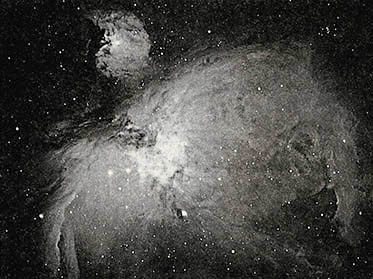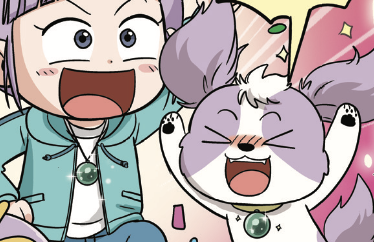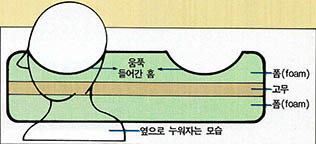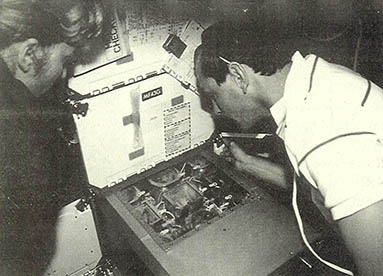
'오리온 자리의 새로운 별 !'과 같은 천문학에 관한 헤드라인이 요즘와서 흔하게 보이고 있다. 그렇다면 오리온은 무엇인지 알아보자. 그리스 신화에 의하면 사냥꾼 오리온은 죄를 범함으로서 다른 신들에게 배척을 받는다(죄의 종류는 신화마다 조금씩 다르다). 그래서 아폴로는 전갈을 바다로 보내어 오리온을 뒤쫓게 한다. 그리고는 계략을 꾸며 사냥의 여신인 아르테미스로 하여금 가련한 오리온을 쏘게 하였다. 오리온을 죽인 아르테미스는 이를 후회하여 전갈과 오리온을 하늘로 보냈다.
오리온 성좌는 지구 대부분의 지역에서 보이며 베델기우스와 이중성인 리겔과 같이 밝은 별을 가지고 있다. 오리온의 칼은 그의 허리춤에 걸려 있는데, 그 칼의 중심에 있는 별이 우리 은하계에서 가장 흥미로운 오리온 대성운이다.
지구에서 1천6백광년이나 떨어져 있는 오리온 성운(M42)은 1694년 네덜란드의 천문학자인 호이겐스에 의해서 처음 보고되었으며 현재 집중적으로 연구되고 있다.
오리온 성단을 맨눈으로 보면 작아서 겨우 보일 정도다. 보통의 쌍안경으로 본다면 보다 밝게 보이지만 흐린 흔적만 분명하게 나타난다. 하지만 망원경으로 본다면 지름이 60광년이나 되는 엄청나게 커다란 거대 성운으로 보인다.
1955년 미국의 천문학자인 조지 허빅은 오리온 성운의 사진을 관찰하던 중 이전의 사진에는 없던 별을 발견하였다. 드디어 별이 태어난 것이다.
별은 GMC라는 거대분자 성운에서 태어나는 것으로 알려져 있다. 그 분자 성운에서 원자는 대부분 수소 분자로 결합되어 있다. 별은 대폭발이 일어날 때 생긴 수소를 사용하여 수소융합 반응을 일으키는 주된 장치이다. 우리 은하계는 5천여개의 이러한 거대분자 성운을 가지고 있으며 이 중에서 우리에게 가장 가까이 있는 것이 오리온 성운이다.
최근 오리온 성운의 북쪽에 있는 별이 새로 만들어지는 지역이 앵글로-오스트레일리안 망원경에 설치된 IRIS 적외선 카메라에 잡혔다. 에핑에 있는 앵글로-오스트레일리안 천문대의 데이빗 알텐과 뉴사우스웨일즈 대학의 마이클 버튼은 이온화된 가스가 매듭처럼 꼬여 있는 이상한 모양의 허빅-해로우 물체를 발견하였다. 그들 중 적어도 일곱은 오리온 성운의 한 지역에 있다.
알렌과 버튼의 이론에 따르면 매듭들이 주위를 둘러 싼 가스를 끌고나갈 때 생긴 것으로 보이는 이러한 흔적들은 불과 1천여년 전에 엄청난 규모의 폭발이 오리온 성운에 있었다는 것을 말해준다고 한다.
폭발이 어떤 종류였는지는 아직 모른다. 그 폭발은 불안정한 표면물질을 가진 젊은 별에서 아주 밝게 순간적으로 타오른 것일 수도 있다. 그 구역에서 FU 오리온과 같은 별은 1936년 타올라서 지금까지도 밝게 빛나고 있다. 알텐과 버튼은 폭발을 설명할 수 있는 다른 가능성으로 오리온 성운의 분자구름에 깊이 숨어있는 초신성의 존재를 들고 있다.
어떤 천문학자들은 오리온 자리를 조사하여 지금 탄생중인 별들을 발견하였다. 분명히 원시형태의 별들은 먼지입자와 분자가스가 중력의 붕괴에 의해서 만들어진 것으로 보인다. 중력 붕괴는 그 자기장이 사라진 다음, 밖으로 향하는 내부 자기력에 의한 압력이 별에서 빠져나간 후에 일어난다.
태양 정도의 큰 별이 만들어지기까지는 수천년이 걸린다. 만일 별들이 오리온 성운과 같이 별들이 밀집해 있는 '양성소'에서만 만들어진다면 왜 은하계의 많은 별들이 대체로 따로 떨어져 있는 것일까.
메사추세츠 대학의 천문학자 카렌 스트롬과 그녀의 동료들은 아직 많이 연구되지 못한 오리온 성운의 남쪽자리를 조사한 적이 있다. 그곳에는 수백개의 새로운 별들이 작은 무리를 지어 있었다. 그 구역에 있는 한 성운에는 10개에서 50개 단위로 뭉쳐진 3천여개의 별들이 있었는데, 이들은 모두 먼지입자로 가득 차 있는 상태다.
이러한 밀집되어 있는 별들은 모두가 가장 젊은 별이다. 이러한 군집에 작용하고 있는 중력에 의한 인력(引力)은 이들을 모여 있게 할 정도로 강력하지 않기 때문에 결국 별들은 따로 떨어져 나온 것이 아닌가 한다. 이것은 왜 태양과 같이 우리 은하계에서 오래된 대부분 별들이 따로 떨어져 존재하는지를 설명해 줄 수 있을 것이다.
스트롬의 가설 중 가장 흥미로운 것은 먼지 입자, 특히 별들의 표면에 있는 먼지의 존재는 행성이 주위의 항성들로 부터 만들어졌다는 사실을 뒷받침한다는 것이다.
태양계 밖에서도 몇몇 커다란 행성들은 어떤 항성 주위로 돌고 있을 것이라는 간접적인 증거는 있지만, 아직 그러한 행성은 보이지 않는다. 오리온 자리에서 별이 만들어지는 곳이 새로이 발견됨으로써 수많은 항성과 행성이 새로이 발견될 것이다. 그리고 우리가 언젠가는 또다른 지구를 발견할지도 모를 일이다.
"New discoveries in Orion!" A familiar astronomical headline these days, but what is orion?
In Greek mythology, the hunter Orion came afoul of the gods by committing sins—the kind depends on the version of the story. Apollo sent a scorpion to chase Orion into the sea, and then tricked the goddess Artemis into shooting the hapless hunter. In remorse, Artemis put the scorpion and the hunter both in the sky.
The constellation of Orion is visible from most of earth and has many bright stars, such as Betelgeuse and the double star Rigel. Hanging from Orion's "belt" is his "sword," and in the middle of the sword is one of the most interesting objects in our Milky Way Galaxy-the Great Nebula in Orion.
Sixteen hundred light-years away from Earth, the Orion Nebula(M42), first described in 1694 by the Dutch astronomer Christian Huygens, is currently under intense investigation.
To the naked eye, the Orion Nebula is a faintly shining patch. With ordinary binoculars, the Nebula appears brighter but distinctly fuzzy, very different from the sharp stars because it is a cloud of gas and dust. Through a telescope, the huge Nebula is stunning, its diameter more than 60 light-years across.
In 1955 the American astronomer George Herbig looked at photos of the Orion Nebula and found two stars not present in older pictures. Stars were being born!
It is now known that stars are born inside the GMC, Giant Molecular Clouds, where atoms are combined into molecules, mostly hydrogen(a star is mainly an enormous hydrogen fusion device, using up the hydrogen produced by the Big Bang). Our Milky Way Galaxy has about 5,000 of these GMC, and the star-birthing Orion Nebula is in the one nearest to us.
Recently the northern star-forming area of the Orion Nebula has been photographed with the infrared camera IRIS on the Anglo-australian Telescope. Australians David A.Allen of the Anglo-Australian Observatory in Epping and Michael G. Burton of the University of New South Wales investigated the strange Herbig-Haro objects, "knots" of shining ionized gas-at least seven of them in one region of the Orion Nebula.
Judging from the "wakes" the knots make as they plow through the surrounding gas, Allen and Burton theorize that less than a thousand years ago there was a tremendous explosion in the Orion Nebula This explosion forcefully ejected the HH clumps of gas outward at high speeds.
It is not known what the explosion was. It could have been the kind of eruption in which young stars with unstable accretion disks can suddenly flare up in brightness. One star in that area, called FU Orionis, flared in 1936 and is still bright. Allen and Burton say that the other possible explanation for the explosion is a supernova deep within the molecular cloud in the Orion Nebula.
Other astronomers have looked into Orion and found stars in the actual process of birth. These "protostars" apparently form from cores of dust and molecular gas that collapse under gravitation. The collapse occurs after the star loses the outward thrust of internal magnetic pressure after its magnetic field disappears.
It takes tens of thousands of years for big stars to form; many more for a star like our Sun. If stars usually form in crowded "nurseries" like the Orion Nebula, why are most of the stars in the galaxy more or less alone?
Astronomer Karen Strom and her colleagues from the University of Massachusetts have looked into the little studied, murky southern area of the Orion Nebula. They found hundreds of new stars clustered in small groups. Within that area, one particular cloud contained 3,000 stars in clusters of from 10 to 50, complete with dust grains.
These dense clusters contain the youngest stars of all. It seems likely that the gravitational attraction in these nursery clusters is not strong enough to hold the groups together, so eventually the stars move apart. This would explain why most of the older stars of the galaxy exist alone, including our Sun.
The most exciting hypothesis of Strom is that the presence of dust grains, especially in disks around the stars, may indicate that planets form early around many stars.
We have yet to see, outside our own solar system, a genuine planet, althouh there's indirect evidence that at least large planets exist around some stars. The new discoveries of star nurseries in Orion give hope that, with so many stars and the possibility of many planets, we may someday find another Earth.
(c) 1993, Los Angeles Times Syndicate
















